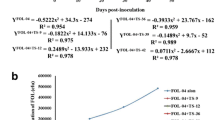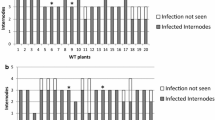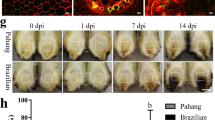Abstract
Fusarium wilt, one of the destructive diseases of cucumber can be effectively controlled by using biocontrol agents such as Trichoderma harzianum. However, the mechanisms controlling T. harzianum-induced enhanced resistance remain largely unknown in cucumber plants. Here we screened the potent T. harzianum isolate TH58 that could effectively control F. oxysporum (FO). Glasshouse efficacy trials also showed that TH58 decreased disease incidence by 69.7 %. FO induced ROS over accumulation, while TH58 inoculation suppressed ROS over accumulation and improved root cell viability under F. oxysporum infection. TH58 inoculation could reverse the FO-induced cell division block and regulate the proportional distribution of nuclear DNA content through inducing 2C fraction. Moreover, the expression levels of cell cycle-related genes such as CDKA, CDKB, CycA, CycB, CycD3;1 and CycD3;2 in TH58 - pre-inoculated seedlings were up-regulated compared with those infected with FO alone. Taken together, these results suggest that T. harzianum improved plant resistance against Fusarium wilt disease via alterations in nuclear DNA content and cell cycle-related genes expression that might maintain a lower ROS accumulation and higher root cell viability in cucumber seedlings.




Similar content being viewed by others
References
Aleandri, M. P., Chilosi, G., Bruni, N., Tomassini, A., Vettraino, A. M., & Vannini, A. (2015). Use of nursery potting mixes amended with local Trichoderma strains with multiple complementary mechanisms to control soil-borne diseases. Crop Protection, 67, 269–278.
Barow, M., & Meister, A. (2003). Endopolyploidy in seed plants is differently correlated to systematics, organ, life strategy and genome size. Plant, Cell & Environment, 26, 571–584.
Baxter, A., Mittler, R., & Suzuki, N. (2015). ROS as key players in plant stress signaling. Journal of Experimental Botany, 65, 1229–1240.
Bertin, N. (2005). Analysis of the tomato fruit growth response to temperature and plant fruit load in relation to cell division, cell expansion and DNA endoreduplication. Annals of Botany, 95, 439–447.
Blaya, J., López-Mondéjar, R., Lloret, E., Pascual, J. A., & Ros, M. (2013). Changes induced by Trichoderma harzianum in suppressive compost controlling Fusarium wilt. Pesticide Biochemistry and Physiology, 107, 112–119.
Booth, C. (1971). The genus Fusarium. Commonwealth Mycological Institute: Surrey, UK.
Cools, T., & De Veylder, L. (2009). DNA stress checkpoint control and plant development. Current Opinion in Plant Biology, 12, 23–28.
Cordero-Ramirez, J. D., Lopez-Rivera, R., Figueroa-Lopez, A. M., Mancera-Lopez, M. E., Martinez-Alvarez, J. C., Apodaca-Sanchez, M. A., et al. (2013). Native soil bacteria isolates in Mexico exhibit a promising antagonistic effect against Fusarium oxysporum f. Sp radicis-lycopersici. Journal of Basic Microbiology, 53, 838–847.
Dewitte, W., & Murray, J. A. H. (2003). The plant cell cycle. Annual Review of Plant Biology, 54, 235–264.
Ding, J., Zhang, Y., Zhang, H., Li, X., Sun, Z., Liao, Y., et al. (2014). Effects of Fusarium oxysporum on rhizosphere microbial communities of two cucumber genotypes with contrasting Fusarium wilt resistance under hydroponic condition. European Journal of Plant Pathology, 140, 643–653.
Ding, Z., Li, M., Sun, F., Xi, P., Sun, L., Zhang, L., & Jiang, Z. D. (2015). Mitogen-activated protein kinases are associated with the regulation of physiological traits and virulence in Fusarium oxysporum f. sp. cubense. PloS One, 10, e0122634.
Dmitrovic, S., Simonovic, A., Mitic, N., Savic, J., Cingel, A., Filipovic, B., et al. (2015). Hairy root exudates of allelopathic weed Chenopodium murale L. Induce oxidative stress and down-regulate core cell cycle genes in Arabidopsis and wheat seedlings. Plant Growth Regulation, 75, 365–382.
Doulis, A. G., Debian, N., Kingston-Smith, A. H., & Foyer, C. H. (1997). Differential localization of antioxidants in maize leaves. Plant Physiology, 114, 1031–1037.
El Komy, M. H., Saleh, A. A., Eranthodi, A., & Molan, Y. Y. (2015). Characterization of novel Trichoderma asperellum isolates to select effective biocontrol agents against tomato Fusarium wilt. Plant Pathology Journal, 31, 50–60.
Elstner, E. F., & Heupel, A. (1976). Oxygen activation by isolated chloroplasts from Euglena gracilis. Isolation and properties of a fluorescent compound that catalyzes monovalent oxygen reduction. Archives of Biochemistry and Biophysics, 173, 614–622.
Engler, J. D., & Gheysen, G. (2013). Nematode-induced endoreduplication in plant host cells: why and how? Molecular Plant-Microbe Interactions, 26, 17–24.
Ezaki, B., Gardner, R. C., Ezaki, Y., & Matsumoto, H. (2000). Expression of aluminum-induced genes in transgenic Arabidopsis plants can ameliorate aluminum stress and/or oxidative stress. Plant Physiology, 122, 657–665.
Ferrigo, D., Raiola, A., Piccolo, E., Scopel, C., & Causin, R. (2014). Trichoderma harzianum T22 induces in maize systemic resistance against Fusarium verticillioides. Journal of Plant Pathology, 96, 133–142.
Galbraith, D. W., Harkins, K. R., Maddox, J. M., Ayres, N. M., Sharma, D. P., & Firoozabady, E. (1983). Rapid flow cytometric analysis of the cell cycle in intact plant tissues. Science, 220, 1049–1051.
Gilissen, L. J. W., van Staveren, M. J., Creemers-Molenaar, J., & Verhoeven, H. A. (1993). Development of polysomaty in seedlings and plants of Cucumis sativus L. Plant Science, 91, 171–179.
Greilhuber, J. (2008). Cytochemistry and C-values: the less-well-known world of nuclear DNA amounts. Annals of Botany, 101, 791–804.
Hano, C. Addi, M., Fliniaux, O., Lamine, B., Eric, D., François, M., Frédéric, L., & Lainé E. (2008). Molecular characterization of cell death induced by a compatible interaction between Fusarium oxysporum f. Sp. linii and flax (Linum usitatissimum) cells. Plant Physiology and Biochemistry, 46, 590–600.
Innocenti, G., Roberti, R., & Piattoni, F. (2015). Biocontrol ability of Trichoderma harzianum strain T22 against Fusarium wilt disease on water-stressed lettuce plants. BioControl, 60, 573–581.
Inzé, D., & De Veylder, L. (2006). Cell cycle regulation in plant development. Annual Review of Genetics, 40, 77–105.
Isack, Y., Benichis, M., Gillet, D., & Gamliel, A. (2014). A selective agar medium for isolation, enumeration and morphological identification of Fusarium proliferatum. Phytoparasitica, 42, 1–7.
Ito, S., Ihara, T., Hideyuki, T., Tanaka, S., Ikeda, T., Kajihara, H., Dissanayake C., Abdel-Motaal F. F., & El-Sayed M. A. (2007). α-Tomatine, the major saponin in tomato, induces programmed cell death mediated by reactive oxygen species in the fungal pathogen Fusarium oxysporum. FEBS Letters, 581, 3217–3222.
Larkin, R. P., & Fravel, D. R. (2002). Effects of varying environmental conditions on biological control of Fusarium wilt of tomato by nonpathogenic Fusarium spp. Biological Control, 92, 160–1166.
Livak, K. J., & Schmittgen, T. D. (2001). Analysis of relative gene expression data using real-time quantitative PCR and the 2-∆∆CT method. Methods, 25, 402–408.
Liu, A. R., Chen, S. C., Jin, W. J., Yu, B. B., Wang, F. H., & He, C. X. (2012). Effects of Trichoderma harzianum on secondary metabolites in cucumber roots infected with Fusarium oxysporum. Chinese Journal of Biological Control, 4, 545–551 (in Chinese).
López-Bucio, J., Pelagio-Flores, R., & Herrera-Estrella, A. (2015). Trichoderma as biostimulant: exploiting the multilevel properties of a plant beneficial fungus. Scientia Horticulturae, 196, 109–123.
Martinez-Medina, A., Pascual, J. A., Perez-Alfocea, F., Albacete, A., & Roldan, A. (2010). Trichoderma harzianum and Glomus intraradices modify the hormone disruption induced by Fusarium oxysporum infection in melon plants. Phytopathology, 100, 682–688.
Marzano, M., Gallo, A., & Altomare C. (2013). Improvement of biocontrol efficacy of Trichoderma harzianum vs. Fusarium oxysporum f. Sp. lycopersici through UV-induced tolerance to fusaric acid. Biological Control, 67, 397–408.
Menges, M., Samland, A. K., Planchais, S., & Murray, J. A. H. (2006). The D-type cyclin CYCD3;1 is limiting for the G1-to-S-phase transition in Arabidopsis. Plant Cell, 18, 893–906.
Petrov, V., Hille, J., Mueller-Roeber, B., & Gechev, T. S. (2015). ROS-mediated abiotic stress-induced programmed cell death in plants. Frontiers in Plant Science, 6, 69.
Porceddu, A., Stals, H., Reichheld, J. P., Segers, G., De Veylder, L., Barroco, R. P., et al. (2001). A plant-specific cyclin-dependent kinase is involved in the control of G2/M progression in plants. The Journal of Biological Chemistry, 276, 36354–36360.
Reichheld, J. P., Vernoux, T., Lardon, F., Montagu, M. V., & Inzé, D. (1999). Specific checkpoints regulate plant cell cycle progression in response to oxidative stress. Plant Journal, 17, 647–656.
Repetto, O., Massa, N., Gianinazzi-Pearson, V., Dumas-Gaudot, E., & Berta, G. (2007). Cadmium effects on populations of root nuclei in two pea genotypes inoculated or not with the arbuscular mycorrhizal fungus Glomus mosseae. Mycorrhiza, 17, 111–120.
Rewers, M., & Sliwinska, E. (2014). Endoreduplication in the germinating embryo and young seedling is related to the type of seedling establishment but is not coupled with superoxide radical accumulation. Journal of Experimental Botany, 65, 4385–4396.
Rymen, B., Fiorani, F., Kartal, F., Vandepoele, K., Inzé, D., & Beemster, G. T. S. (2007). Cold nights impair leaf growth and cell cycle progression in maize through transcriptional changes of cell cycle genes. Plant Physiology, 143, 1429–1438.
Saravanakumar, K., Yu, C. J., Dou, K., Wang, M., Li, Y., & Chen, J. (2016). Synergistic effect of Trichoderma-derived antifungal metabolites and cell wall degrading enzymes on enhanced biocontrol of Fusarium oxysporum f. Sp. Cucumerinum. Biological Control, 94, 37–46.
Schuster, A., & Schmoll, M. (2010). Biology and biotechnology of Trichoderma. Applied Microbiology and Biotechnology, 87, 787–799.
Scott, J. C., Gordon, T. R., Kirkpatrick, S. C., Koike, S. T., Matheron, M. E., Ochoa, O. E., et al. (2012). Crop rotation and genetic resistance reduce risk of damage from Fusarium wilt in lettuce. California Agriculture, 66, 20–24.
Shadel, G. S., & Horvath, T. L. (2015). Mitochondrial ROS signaling in organismal homeostasis. Cell, 163, 560–569.
Sliwinska, E., & Lukaszewska E. (2005). Polysomaty in growing in vitro sugar-beet (Beta vulgaris L.) seedlings of different ploidy level. Plant Science, 168, 1067–1074.
Srivastava, R., Khalid, A., Singh, U. S., & Sharma, A. K. (2010). Evaluation of arbuscular mycorrhizal fungus, fluorescent Pseudomonas and Trichoderma harzianum formulation against Fusarium oxysporum f. Sp lycopersici for the management of tomato wilt. Biological Control, 53, 24–31.
Suzuki, K., Nishiuchi, T., Nakayama, Y., Ito, M., & Shinshi, H. (2006). Elicitor-induced down-regulation of cell cycle-related genes in tobacco cells. Plant, Cell & Environment, 29, 183–191.
Tan, J. Y., Shao, X. H., Chen, L. H., Chen, L. N., & Xu, H. L. (2012). Effect of formulations of Trichoderma harzianum SQR-T037 on the induction of resistance against Fusarium wilt in cucumber. Journal of Agricultural and Food Chemistry, 10, 1205–1209.
Tsukagoshi, H. (2012). Defective root growth triggered by oxidative stress is controlled through the expression of cell cycle-related genes. Plant Science, 197, 30–39.
Verma, M., Brar, S. K., Tyagi, R. D., Surampalli, R. Y., & Valero, J. R. (2007). Antagonistic fungi, Trichoderma spp.: panoply of biological control. Biochemical Engineering Journal, 37, 1–20.
Vinale, F., Sivasithamparam, K., Ghisalberti, E. L., Marra, R., Woo, S. L., & Lorito, M. (2008). Trichoderma–plant–pathogen interactions. Soil Biology & Biochemistry, 40, 1–10.
West, G., Inzé, D., & Beemster, G. T. S. (2004). Cell cycle modulation in the response of the primary root of Arabidopsis to salt stress. Plant Physiology, 135, 1050–1058.
Willekens, H., Chamnongpol, S., Davey, M., Schraudner, M., Langebartels, C., Van Montagu, M., et al. (1997). Catalase is a sink for H2O2 and is indispensable for stress defence in C3 plants. EMBO Journal, 16, 4806–4816.
Xia, X. J., Zhou, Y. H., Ding, J., Shi, K., Asami, T., Chen, Z. X., et al. (2011). Induction of systemic stress tolerance by brassinosteroid in Cucumis sativus. New Phytologist, 191, 706–720.
Xiong, W., Li, Z. G., Liu, H. J., Xue, C., Zhang, R. F., Wu, H. S., et al. (2015). The effect of long-term continuous cropping of black pepper on soil bacterial communities as determined by 454 pyrosequencing. PloS One, 10, e0136946.
Yin, K., Ueda, M., Takagi, H., Kajihara, T., Aki, S. S., Nobusawa, T., et al. (2014). A dual-color marker system for in vivo visualization of cell cycle progression in Arabidopsis. Plant Journal, 80, 541–552.
Yu, J. Q., & Komada, H. (1999). Hinoki bark, a substrate with antipathogen properties that suppress root diseases of tomato. Scientia Horticulturae, 81, 13–24.
Zhang, F. G., Yang, X. M., Ran, W., & Shen, Q. R. (2014). Fusarium oxysporum induces the production of proteins and volatile organic compounds by Trichoderma harzianum T-E5. FEMS Microbiology Letters, 359, 116–123.
Zhang, Y., Gu, M., Shi, K., Zhou, Y. H., & Yu, J. Q. (2010). Effects of aqueous root extracts and hydrophobic root exudates of cucumber (Cucumis sativus L.) on nuclei DNA content and expression of cell cycle-related genes in cucumber radicles. Plant and Soil, 327, 455–463.
Zhao, F. Y., Hu, F., Zhang, S. Y., Wang, K., Zhang, C. R., & Liu, T. (2013). MAPKs regulate root growth by influencing auxin signaling and cell cycle-related gene expression in cadmium-stressed rice. Environmental Science and Pollution Research, 20, 5449–5460.
Zuo, C. W., Li, C. Y., Li, B., Wei, Y. R., Hu, C. H., Yang, Q. S., et al. (2015). The toxic mechanism and bioactive components of Chinese leek root exudates acting against Fusarium oxysporum f. Sp. cubense tropical race 4. European Journal of Plant Pathology, 143, 447–460.
Acknowledgments
This work was supported by National Natural Science Foundation of China (31471867, 31560554, 31260478, 31550110201), Flexible Talent Introduction Project of Agricultural and Animal Husbandry College of Tibet University (201406) and Outstanding Young Teacher Project in Henan Province (2011GGJS-075, 2012GGJS-078).
Author information
Authors and Affiliations
Corresponding author
Rights and permissions
About this article
Cite this article
Chen, SC., Zhao, HJ., Wang, ZH. et al. Trichoderma harzianum-induced resistance against Fusarium oxysporum involves regulation of nuclear DNA content, cell viability and cell cycle-related genes expression in cucumber roots. Eur J Plant Pathol 147, 43–53 (2017). https://doi.org/10.1007/s10658-016-0978-7
Accepted:
Published:
Issue Date:
DOI: https://doi.org/10.1007/s10658-016-0978-7




